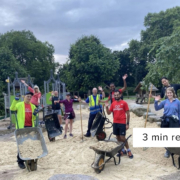I recently took a deep dive into my finances. I’d been putting it off for far too long. Getting started was hard – looking at my day-to-day spending, thinking about my short and my long-term goals – and the process was laborious at times. But by the time I’d finished I felt emotionally cleansed – like the way you feel when you’ve just purged the messiest draw in the house and now you can find things and it shuts! Now I feel inwardly confident because I have a more realistic picture of what’s going on with my finances – I’m clear about my options and I have a plan.
Why is financial wellbeing important?
It’s like having a safety net for your money.
Life’s full of unexpected twists and being financially resilient helps you to navigate through tough times with less stress.
It’s about having enough savings, managing debts and planning for the future. Whether you’re just starting or already managing your money, the steps below will help you understand financial security and move towards achieving it.
- Reflect on 2023 goals
Take a moment to think about the goals you set last year. Did you plan to save money, spend less or start an emergency fund? Reflecting on your progress is helpful but remember it’s not about being perfect, it’s about understanding where you stand financially. Celebrate those successes too! If you didn’t set any goals last year, make sure you set some for 2024 once you’ve worked your way through the steps below.
- Assess your current financial health
Check your bank statements, credit card bills and financial records for the past three months. What were your spending habits? Are there any surprises? Don’t scrimp on this, if you need to go back six months to get an accurate picture, do it. Understanding how the money flows in and out will help you make better decisions.
- Create a realistic monthly budget
Budgeting might sound complicated but it’s simpler than it seems. Create a realistic monthly budget by listing your income (usually your salary) and categorising your expenses (gym, phone, electricity for example). What’s necessary, and what’s a splurge? Identify areas where you can save a bit more – these small changes can add up over time. If you can’t save right now, that’s okay too.
- Build an emergency fund
Emergency funds act like a safety net for your finances. Aim to save three to six months’ worth of living expenses to help cover you if something unexpected happens. You can also explore saving and investing options based on your comfort level and goals. Spread your investments – think about pensions, ISAs, or maybe even stocks. The aim is to make your money work for you, or at the very least not lose value.
- Understand your debt
Facing debt can be tough but tackling it head-on is liberating. Get a clear picture of your debt – how much do you owe, where and to who. Prioritise high-interest debts and create a plan to pay them off. You could also think about consolidating your debt or talk to your creditors to find out if there are other payment options available. Starting early leads to financial freedom sooner.
For more information visit Debt Advice Foundation
Navigating the path to financial security
Financial resilience is an ongoing journey. It’s about understanding your goals, managing your money wisely and adapting when you need to. For me the hardest part was going through my old statements to get an accurate picture of my spending habits – it will be different for everyone, but I can promise you, you’ll be glad you did it!
If you’d like more information visit MoneyHelper or the government’s Mid-life MOT website for more tailored information.





